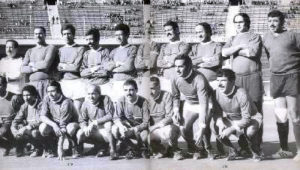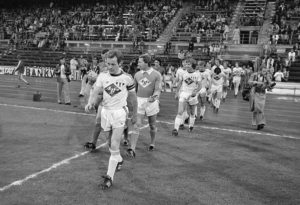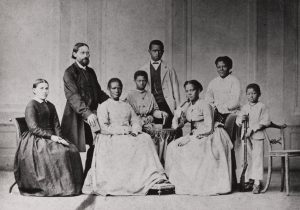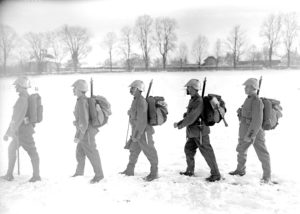
Swiss National Museum / ASL
Political and economic aspects in football
Football is more than just a sport. It’s culture and entertainment, politics and business, the regular crowd around their usual table and the select few in the VIP lounge.
Does football have a political force? Can it even end a war or resolve a grievance? It can at least make people aware of these things. In autumn 1995, when Alain Sutter played with the Swiss national team against Sweden, something unusual happened. During the national anthem, Sutter and his teammates unfurled a piece of cloth. It had the words ‘Stop it, Chirac’ spray-painted on it. This protest against French atomic bomb testing on Mururoa Atoll was a political act that generated debate for a long time afterwards. More so, in any case, than the goalless draw that followed in the game against Sweden.
In 2006, former Chelsea striker Didier Drogba called for a ceasefire between the combatants in his homeland of Côte d’Ivoire. His plea was answered, marking the end of a long-running civil war. In the 1950s, one of Africa’s most talented footballers, Rachid Mekhloufi, even sacrificed his career for his fellow countrymen. Born in French-occupied Algeria, as a child Mekhloufi witnessed the Sétif massacre, which claimed tens of thousands of victims. However, he later moved to the country of the colonial masters to play for AS Saint-Etienne, where, together with other North Africans, he was one of the league’s most exciting players.
In 1954 the Algerian war of independence broke out, but the global public hardly noticed. So the liberation movement Front de Libération Nationale (FLN) turned to the power of sport. In 1958 a dozen Algerian footballers, including Rachid Mekhloufi and other French internationals, relocated from Europe and joined forces to form the unofficial Algerian national team. The purpose of Algeria’s propaganda eleven, when playing international tournaments, was to call attention to the suffering in the players’ homeland: a life full of hardship and deprivation instead of one as a celebrated professional player on a princely salary. But the team also set the standard in football, for instance trouncing European champions Yugoslavia 6-1 in front of 80,000 spectators.
The FLN was active for four years, until France finally gave Algeria its independence. Many of the players decided to stay in North Africa, but Mekhloufi was keen to get back to his old life. At Servette in Geneva, he regained his fitness, scoring 10 goals in 11 games, before rejoining AS Saint-Étienne. In 1968 the club were French champions; the Cup Final in the same year became Mekhloufi’s personal victory parade. He scored two goals, and at the reception afterwards President Charles de Gaulle greeted him with words which, when he had left the country ten years earlier, he would never have dreamt he would hear: ‘La France, c’est vous!’

Didier Drogba in the 2012 Champions League final.
Wikimedia

The FLN team playing an exhibition game in 1974.
Wikimedia


FC Zurich was the first Swiss club, in 1976, to place advertising on its players’ shirts. The first sponsor was emblazoned on the Zurich players’ chests at Köbi Kuhn’s last championship game in 1977.
FCZ Museum
HEATED DEBATE OVER ADVERTISING ON FOOTBALL SHIRTS
Advertising has become an integral part of football. Every possible surface in a stadium is plastered with a sponsor’s logo; the most sought-after place, of course, is on the front of the players’ shirts. However, there was initially resistance to this development. In the 1950s superstar Obdulio Varela, captain of Uruguay’s national team, refused to run out for his club, Peñarol Montevideo, in a jersey with advertising slogans on it: ‘They used to drag us blacks around by rings in our noses. Those days are gone.’
In Switzerland, it was much longer before clubs discovered this source of income. The first to embrace the trend was FC Zurich in 1976, when players advertised a photographic film manufacturer on their shirts. FC Basel, the Young Boys and Lausanne followed suit shortly afterwards. For Schweizer Fernsehen, the Swiss television broadcaster, this was not acceptable. The provider railed against the new form of advertising, because it meant companies would receive a platform without paying for it. SRG promptly stopped covering matches involving the clubs it criticised. This in turn caused outrage among fans, particularly as even more space was given over to ‘unpaid’ advertising in broadcasts of skiing events and Formula 1 racing. The boycott didn’t last long – and the two-year trial with jersey sponsors arranged by the Football Association transitioned seamlessly into a permanent situation.
Football shirt advertising was equally contentious in Germany. Eintracht Braunschweig circumvented the ban in force by immediately adopting the symbol of alcohol manufacturer Jägermeister as its club logo. Even after this type of advertising was allowed, some newspapers still blacked out audacious photos of players with advertising on their jerseys.
Tempi passati: Manchester United currently receives the record sum of 80 million francs a year from a car manufacturer in return for space on the team’s jersey, which is also worn by millions of fans across the globe – who thus also become walking advertisements.
The mini football revolution in Braunschweig.
YouTube



